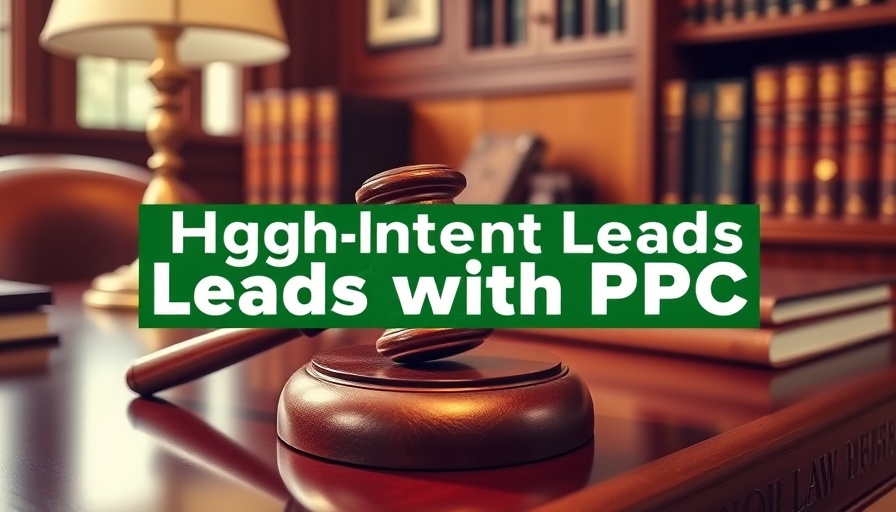
Unlock High-Intent Leads: The Power of PPC Advertising
In today's competitive legal market, law firms must adopt innovative strategies to attract clients actively seeking legal assistance. Pay-per-click (PPC) advertising stands out as a robust avenue for generating high-intent leads that convert into clients. By utilizing PPC effectively, legal practices can worldwide attract potential clients who are not just browsing the web but are ready to take action. Let’s explore how implementing PPC can dramatically increase lead quality and quantity for legal services.
Understanding High-Intent Leads in the Legal Sector
High-intent leads refer to individuals who show a clear intention to seek legal help, often searching for specific keywords like “personal injury lawyer near me” or “family law attorney.” Understanding the psychology of these searches is crucial. When a potential client searches for solutions, they are usually experiencing an urgent need for assistance, making them prime candidates for conversion when targeted correctly. PPC advertising focuses on these specific intent-driven keywords, positioning your firm where potential clients are actively seeking help.
Why PPC is Essential for Lawyers and Legal Firms
With the rise of digital marketing, it has become essential for law firms to maintain an online presence. PPC advertising provides immediate visibility on search engines like Google, ranking you above organic listings. This instant reach can significantly enhance your visibility among potential leads who might not find you otherwise. Moreover, PPC allows for precision targeting, enabling firms to showcase their services to the most relevant demographics, thereby increasing the chances of converting leads into clients.
Crafting Effective PPC Campaigns: Key Strategies
Creating an effective PPC campaign that captures high-intent leads requires a strategic approach. Here are several critical elements to consider:
- Keyword Research: Utilize tools like Google Keyword Planner or SEMrush to identify high-traffic keywords relevant to your practice areas. Carefully curated lists of keywords will ensure you reach users who are actively searching for your specific services.
- Ad Extensions: Implementing ad extensions can provide additional information and encourage clicks. These include site links, call buttons, and even customer reviews, increasing the ad's attractiveness.
- Landing Page Optimization: When a lead clicks your ad, they should land on a well-optimized webpage that provides immediate value. Ensure your landing pages highlight your legal expertise and encourage visitors to take action—whether contacting you directly or filling out a consultation form.
Measuring Success: PPC Analytics and Reporting
To truly benefit from PPC, law firms must continuously analyze campaign performance using tools like Google Analytics. Track metrics such as click-through rates (CTR), cost per click (CPC), and conversion rates. Understanding these figures allows firms to adjust their strategies and enhance their effectiveness. For instance, if certain keywords yield low conversion rates, reallocating budget to more effective terms can maximize ROI.
Local SEO and PPC: A Synergistic Approach
Incorporating local SEO techniques into your PPC strategies can further enhance lead generation. By leveraging local keywords and creating location-based campaigns, such as “criminal attorney in [Your City],” you can dominate local search results and attract community clients effectively. Furthermore, reviews and citations improve both SEO and PPC efforts, leading to higher trust and credibility among potential clients.
Future Trends in PPC Advertising for Legal Practices
As digital marketing evolves, so do the strategies legal firms must adopt. Future trends indicate a growing focus on AI-driven tools, which can predict user behavior and automate bidding strategies. These advancements will allow legal practices to streamline their PPC campaigns, ensuring a more effective allocation of their advertising budget while maximizing lead acquisition.
Conclusion: Take Action to Boost Your Firm's Growth
For legal practices aiming to improve their lead acquisition strategies, investing in PPC advertising is not just beneficial; it is essential. The ability to target high-intent users actively seeking legal help provides a golden opportunity to convert clicks into clients. Integrating PPC campaigns with a focus on local SEO and continuous optimization can transform your firm’s marketing approach, ensuring long-term success. Start leveraging PPC today and witness how it can propel your practice to new heights.
Actively update your PPC campaigns and invest in strategy refinement to improve your legal firm's outcomes. Consistent innovation in your approach will keep you ahead in this rapidly evolving digital marketing landscape.
 Add Row
Add Row  Add
Add 




Write A Comment